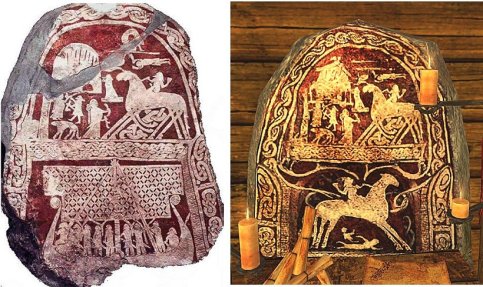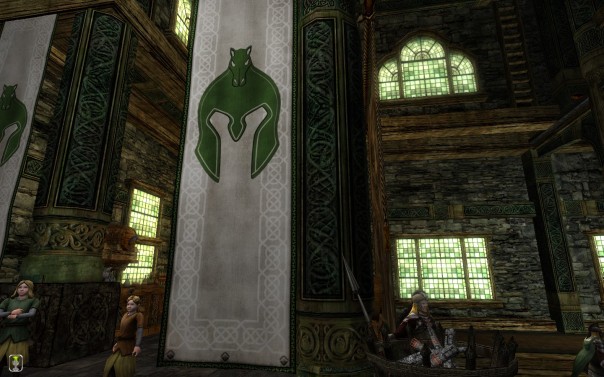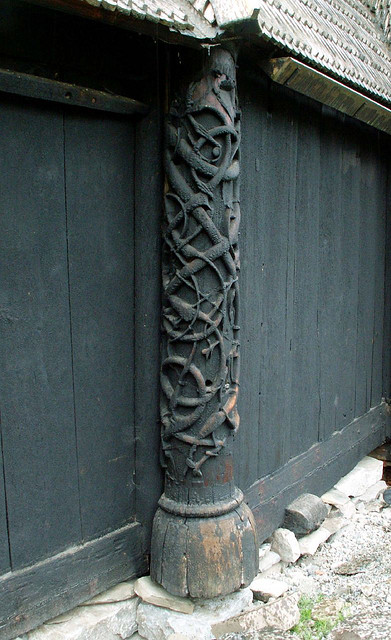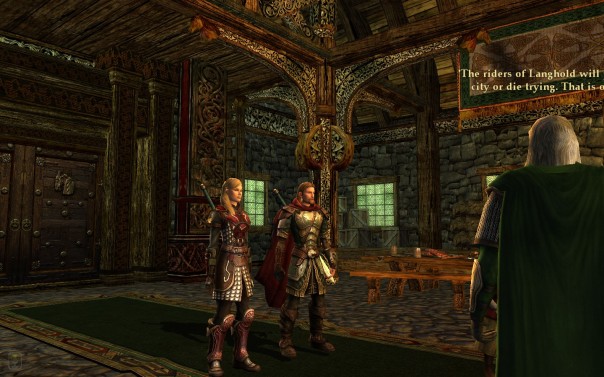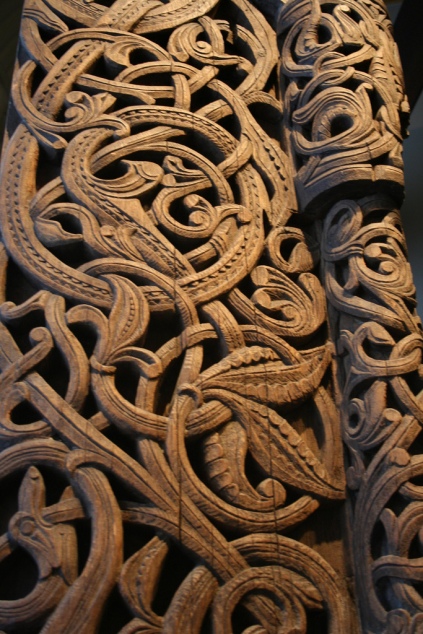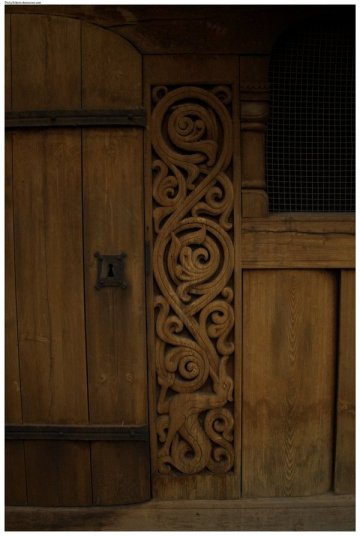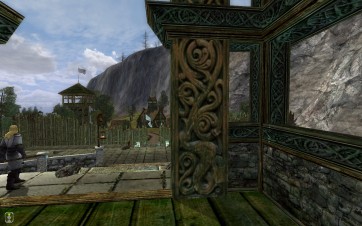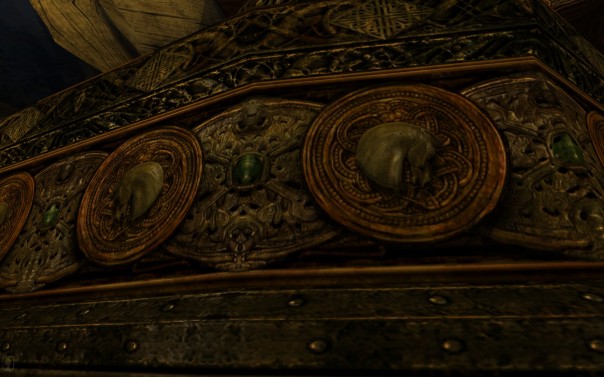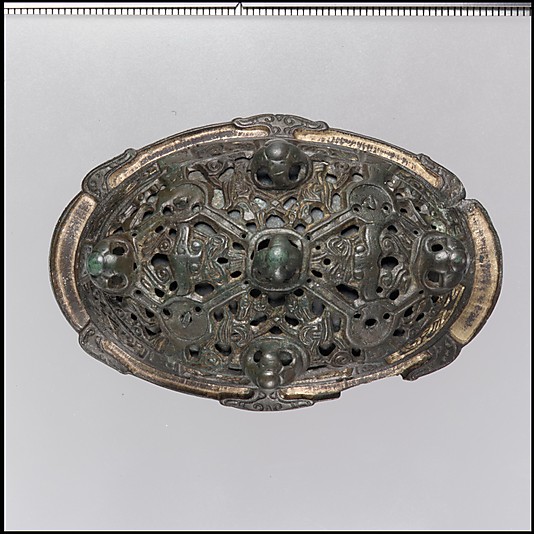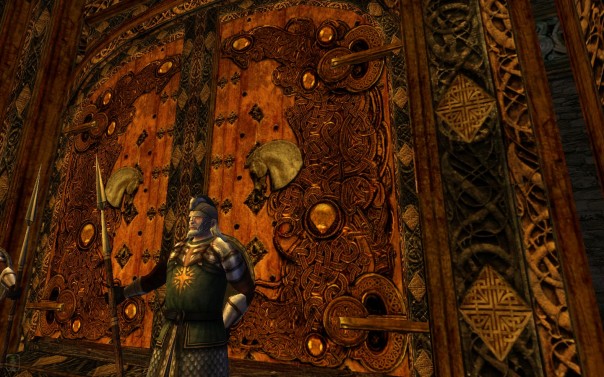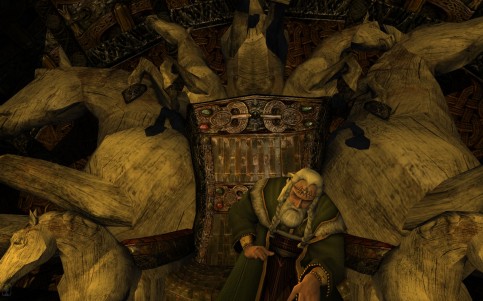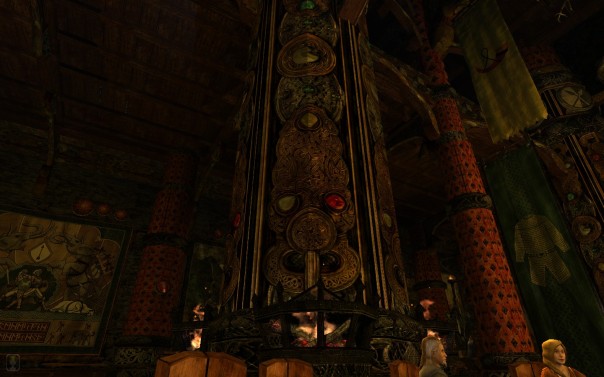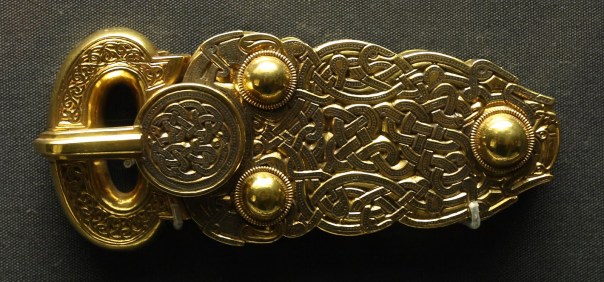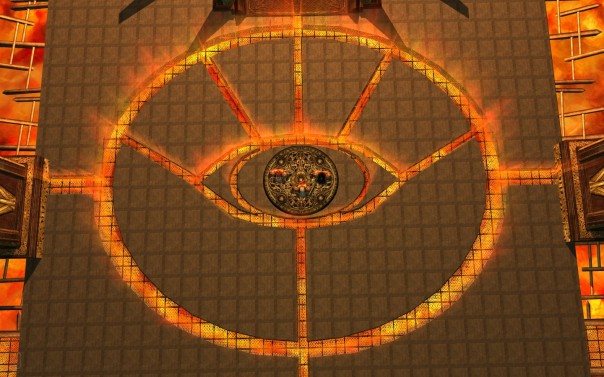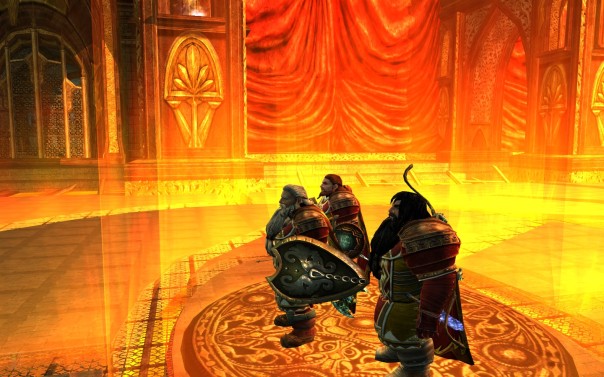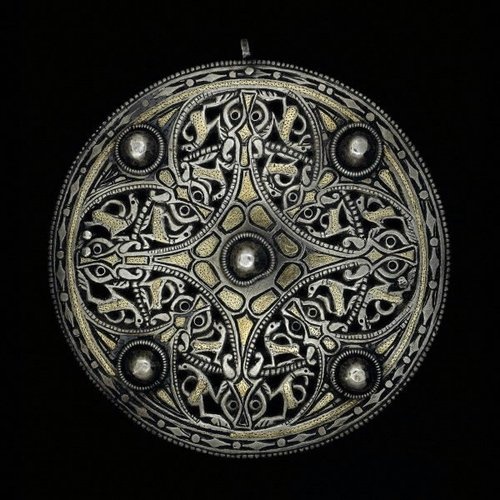Category Archives: Lore
Anglo-Saxon and Viking designs in LOTRO
I was recently intrigued by a post on the forums, where someone had spotted the fact that the famous Gotlandic picture stone depicting Sleipnir and a Valkyrie had been used, very cleverly, as the new superior scholars craft object. I had noticed this with the Great River expansion, but hadn’t, incorrectly, actually considered it of much interest to other people. For those of you who don’t know, my real life profession is an Archaeologist, and like many archaeologists the world in which I work sadly has far more to do with cold wet muddy fields in Yorkshire than expeditions to the Congo and Egypt, and more trawling through computer files and boxes of dull 19th century pottery than meticulous work under microscopes on ancient artefacts… however it does have its moments, and does have some uses in Pub quizzes and geeking out in computer games like LOTRO.
A period I have always loved, and been fortunate enough to work on sites from, is the Early medieval period in Britain, often called the Anglo-Saxon or Viking period. This era stretched from just after the Romans relinquished control of the lands they occupied in the British Isles around the beginning of the 5th century, to the 11th century following the conquest of Britain by the Normans (themselves actually descended from Vikings) over a period of years after 1066. It was a period dominated by the Pagan originated cultures of Norway, Denmarks, Sweden, the Netherlands, and Northern Germany, and is a period from which in Britain, and abroad, many of the historic texts Tolkien loved originated, and many of the cultures he designed had their roots.
Working on any period in archaeology means you build up a mental collage of designs and objects from the period of study.This is especially true when you have a finds specialism as I do, where over time you build up a mental reference library of information and images from which you draw parallels, and avenues of research, and comparison, to the current objects you may be studying. I have often recognised designs in LOTRO clearly influenced by actual historical styles and designs, and the Rohan expansion is no exception, drawing on Saxon and Viking age imagery more than ever, so I thought I’d take this opportunity to point a few of the more tangible and recognisable ones to you.
The below image is taken from the Cliving mead hall, and the dark design on the pillars is a texture used in Rohan, and is immediately recognisable as a piece of Urnes style art from the late viking period (11th-12th century), usually found on stave churches.
Compare it with the below panel from the actual stave chruch at Urnes
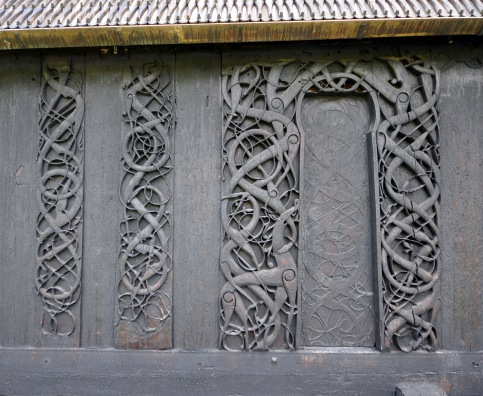
I am fairly certain that the texture is actually a Photoshop manipulated version of this carving, as I can see the same tendrils and terminals as on the above examples, though it has been carefully Photoshopped to form a closed figure of eight, more suitable for game textures (I sure hope they paid their usage fees if they got it off the web!). You will see this texture tweaked and reworked, again and again, in Rohan, from small details and architectural features, to chunks of barge boards on building eaves, but especially in Cliving where it forms a large percentage of the textures used.
Another nice touch are the following carvings, found even more commonly. You can see the largest unmanipulated chunks on the large pillar to the right of the door, and the diagonal beams in the roof, and more heavily manipulated on the pillars and other surfaces.
Theses are clearly derived from a beautiful series of acanthus scroll carvings (a sample image of them below), also from a Norwegian stave church, and particularly these examples from Heddal stave church in Norway (also below). As before there has been a lot of manipulation and Photoshop work to stitch these together and adapt to a usable pattern, but there are still large and readily identifiable portions, and they can be seen on many elements from beams and eaves boards, to the Rohan milestone.
Next up we have some rather odd, but perfectly period appropriate designs, though perhaps a little less more clumsily added to the objects in the virtual world. Obviously the below image from Meduseld itself has some more Urnes artwork manipulated for its top border, but it is the circular and oval motifs forming the border below that most interest me.
As you can see below, the central oval portion with the green ‘gem’, is simply this image below of a 9th-10th century viking oval brass brooch, worn by women in pairs to hold up their dress, possibly named a Smokkr… though often called slightly erroneously a hangerok by reenactors. Indeed, I think it is literally just this image with the central portion turned green.
The two circular designs flanking are extracted from the next object, which also adorns many surfaces in Meduseld, from the gate, the fixtures, to the king’s throne itself. Again you can see the Urnes designs worked into the walls, but what I ask you to look at here is the metal work and hinges on the doors.
Here you can see similar designs on the top edge of the king’s throne, with red and green highlighted gems
And finally, on the main pillars in Meduseld, the full object is visible, with highlighted bosses, again with our Petersen P51 oval brooch behind it.
This is, of course, the fabulous belt buckle set from the Sutton Hoo burial (below), buried in the 7th century, and probably belonging to Raedwald, the King of the East Anglians and High King of Britain, who was, interestingly enough, actually from a Swedish dynasty called the Wuffingas.
If you keep your eyes open you will see these designs again, and again. You will also spot that many of the building in Rohan are remarkably similar to Norwegian Stave churches and Saxon buildings. One of the great strengths of Peter Jackson’s adaptations of Tolkiens works, is his art departments ability to look carefully at historic cultures that influenced Tolkiens writing, and use these as an inspiration for their designs, and it seems Turbine is doing similar, which I can only applaud… only next time guys, please try to make it look a little less like you cut and pasted a belt buckle onto things!
For those of you wondering if this is a new method by Turbines art department, please take a look at the following screen shot taken many moons ago of the floor in Mordiriths room in Angmar, specificallythe circular thing we are stood on:
… Heres a closer pic under our feet
Finally, here is an image of the 9th century Anglo-Saxon Strickland brooch …familiar at all?
Discovered Documents of the Khazad Guard
 We have just made some exciting discoveries at the Khazad Guard of some ancient Dwarf documents, pertaining to the Khazad Guard. As our detailed analysis is completed we shall bring more information to you, but firstly we have a look at the family tree of the main bloodline of the leadership of the Khazad Guard.
We have just made some exciting discoveries at the Khazad Guard of some ancient Dwarf documents, pertaining to the Khazad Guard. As our detailed analysis is completed we shall bring more information to you, but firstly we have a look at the family tree of the main bloodline of the leadership of the Khazad Guard.
For more information see our main article here
So Really?
O.K, yes, these were all actually drawn and invented by me, though I have spent some time trying to get the dates, runes, and history correct based on Tolkiens Canon. I have never ignored anything of Tolkiens, and designed our entire history and documents to slot into his lore without interfering with it.
I did just start these for fun, but I enjoyed creating them so much I thought I’d carry on, so there may be a few more of these appearing in the future. Finally, though it would appear I have too much time on my hands, I actually haven’t, I just spend what little time I do have unwisely, but hey I’m enjoying myself and not hurting anyone! This one is getting framed and hung up in the house, because we are a bit strange like that!
cheers
Adam
Two LOTR Fan Films
 I’m sure many of you out there already know about these excellent pieces of work, but especially with many new Free-to-Play players I thought I would point you in the direction of some interesting related work, and for those that have seen them before, perhaps prompt you to have a second look!
I’m sure many of you out there already know about these excellent pieces of work, but especially with many new Free-to-Play players I thought I would point you in the direction of some interesting related work, and for those that have seen them before, perhaps prompt you to have a second look!
Both are short (ish) films created by fans for practically non-existent budgets on parts of Tolkien’s appendices from the Lord of the Rings. They fill in aspects of the story chronologically before the Lord of the Rings and provide a little background to the events seen in the books and of course on the big screen in Peter Jackson’s interpretations. They follow a similar film and art style to Peter Jackson’s films, yet I think this is no bad thing, as it means they inherit a lot of the tone and credibility that Peter Jackson and Weta spent of lot of time and money refining, and they spend their time and money adding and embellishing this. I watched them on their respective release days and was blown away, and have periodically popped back to watch them. Born of Hope was particularly interesting to me location wise as I have visited West Stow; the Anglo-Saxon site and reconstructed village, as both an archaeologist and a reenactor, and was intrigued to see what a great Middle Earth set it made!
 The real strength of both stories is that they don’t bite off more than they can chew, and choose to tell a little bit of story very well and in detail, rather than to make a full adventure movie poorly. Both are entirely free to watch, and definitely a very nice bit of background story to the Lord of the Rings Film trilogy as we know them, and indeed LOTRO as a game (Halbarad is in Born of Hope!). So please pop along to their sites and give them a view, you won’t be disappointed!
The real strength of both stories is that they don’t bite off more than they can chew, and choose to tell a little bit of story very well and in detail, rather than to make a full adventure movie poorly. Both are entirely free to watch, and definitely a very nice bit of background story to the Lord of the Rings Film trilogy as we know them, and indeed LOTRO as a game (Halbarad is in Born of Hope!). So please pop along to their sites and give them a view, you won’t be disappointed!
The hunt for Gollum is about Aragorns attempts to track and capture him, and the site can be found here: http://www.thehuntforgollum.com/
Born of Hope tells of the Dunedain of the north and Aragorns Lineage and can be found here: http://www.bornofhope.com/
You want the Symbol… but who is Celebrimbor?
 So you have all coveted those rare (soon to be less so) symbols of Celebrimbor right? But have you ever wondered who he was?
So you have all coveted those rare (soon to be less so) symbols of Celebrimbor right? But have you ever wondered who he was?
Celembrimbor was an elf of the Noldor, whose heritage stretches back to the first age of the world. He was born in Valinor, the land of the Valar to the uttermost West of the world. He was born into great heritage, but also a great doom, as his father was Curufin. Curufin was the fifth son of Feanor, who later made the Simarils, and through the deceits of Morgoth lost them to Him, and led the Noldor through misery and turmoil back to Beleriand, and set them on an accursed quest to recover the lost Silmarils. His father, with others of his brothers behaved shamefully in many respects with regard to forcefully upholding their oath to Feanor, especially with regard to Beren, Luthien and Finrod Felagund, which meant that they were shunned by many of the other Eldar, and thus their oaths to Feanor, ensured the curse of Mandos was upheld:
“Tears unnumbered ye shall shed; and the Valar will fence Valinor against you, and shut you out, so that not even the echo of your lamentation shall pass over the mountains. On the House of Fëanor the wrath of the Valar lieth from the West unto the uttermost East, and upon all that will follow them it shall be laid also. Their Oath shall drive them, and yet betray them, and ever snatch away the very treasures that they have sworn to pursue. To evil end shall all things turn that they begin well; and by treason of kin unto kin, and the fear of treason, shall this come to pass. The Dispossessed shall they be for ever”
Celebrimbor seems to have escaped this doom to a larger extent, perhaps due to his rejection of his fathers deeds, and his refusal to follow them when they were expelled from Nargothrond. However, when the first age was ended and Morgoth overthrown, he did not return to Valinor, though whether this was through choice, or the Curse is uncertain, and he passed over the mountains to dwell in Eriador.
He dwelt for a time in Eregion, and thus learnt much of Ring law from Sauron, is his guise as Annatar. Celebrimbor made the 19 rings as told in the famous rhyme by Gandalf to Frodo. The Seven Rings of the Dwarf lords, the Nine for Mortal men, and the Three of the Elves were all his works. These latter three he created secretly, and thus kept them free of the malign influences of Sauron.
in the famous rhyme by Gandalf to Frodo. The Seven Rings of the Dwarf lords, the Nine for Mortal men, and the Three of the Elves were all his works. These latter three he created secretly, and thus kept them free of the malign influences of Sauron.
When Sauron then forged the one ring and declared himself as lord of Middle Earth Celembrimbor and the Elves of Eregion refused to surrender the rings to him, and thus Sauron attacked Eregion laying waste to it, and leaving it in the state you now find it in LOTRO. In the destruction Celebrimbor was captured by Saurons forces. Under torture he was forced to reveal the whereabouts of the Seven and the Nine, but would not reveal the Three, before dying of his torment, the last descendant of the House of Feanor.
His Sindarin name: Celebrimbor apparently means ‘Silver-fist’ or ‘hand of silver’, from Celeb: Silver and presumably some for of drambor/paur: hand/clenched fist, which I am assuming relates in some way to his craftsmanship. So there he is, if you are ever lucky enough to see one of these drop, or are bartering your marks for one in a few months time, spare a thought for the last of the elf princes of the line of Feanor!
